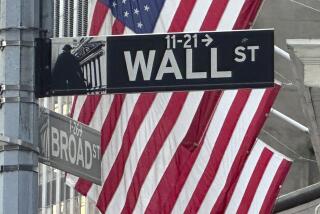Don’t Believe All the Gloomy Economic News
Like a child with recurring colds and fever, the economy continues to cause concern. The government’s leading economic indicators, which allegedly forecast economic activity six to nine months from now, were down sharply Tuesday.
Coming on the heels of other statistics showing declines in manufacturing and slow growth in the first quarter, the news raised a question of whether the economy is falling back into recession.
The answer almost certainly is no. The economy is growing slowly, will probably pick up speed this summer and contains signs of hope: Car sales are up, corporate profits are strong.
Fact is, the so-called leading indicators look backward--their current gloom results from bad weather in March, which held back home building and retail sales, and a really sharp drop in defense business in early ’93. “Defense plummeted,” as another phase of the long-term reduction in military spending kicked in, notes Lynn Reasor, chief economist of First Interstate Bancorp. So recession remains all too real in California, but not elsewhere.
The White House too hinted Tuesday that the latest figures are no cause for alarm. President Clinton didn’t suggest emergency passage of his jobs stimulus package or of tax breaks for industrial investment. Rather he repeated his demand for higher taxes to reduce the federal deficit because that should bring about lower interest rates.
What really lies ahead? A long debate in Washington over taxes and government policies, but otherwise a continuation of the underlying trends of the ‘90s--low inflation, stronger and more profitable U.S. industry and low interest rates. “Both short- and long-term rates will get to surprisingly low levels,” predicts Charles Clough, chief investment strategist of Merrill Lynch.
First the politics. Clinton’s package of $265 billion in new taxes on corporations and individuals went before the House Ways and Means Committee on Tuesday. Coming later this month will be health care reform--which Hillary Rodham Clinton suggests will be paid for by an addition to the Social Security payroll tax. That’s one of many tax proposals by the White House this year.
And that’s part of the economy’s problem, critics charge. “This daily talk of new taxes is causing business and individuals to hold back,” says economist Lawrence Kudlow of Bear Stearns--an economic aide in the early Reagan Administration. Kudlow believes that the economy will grow by more than 3% in this year’s second half, “but it would grow by 4% were it not for all these trial balloons about taxes.”
Business can’t ignore politics, to be sure. Right now, world markets are said to be confused by Clinton’s economic programs and so are pushing down the U.S. dollar’s value. But political reality says that Clinton’s program will be modified in Congress, and, ultimately, what Clinton proposes and Congress disposes will mean deficit reduction. And that will keep interest rates low.
Meanwhile, businesses and individuals hardly seem to be holding back. Business investment in new equipment was up 10% in the first quarter and appears to be continuing at that pace.
Car sales in April, spurred by a strong showing from General Motors, were at their highest levels in almost three years. Dealers expect even better sales in May. Detroit’s auto makers are regaining market share from Japanese brands, which have been forced to raise prices because of currency exchange pressures.
Now there’s an important indicator. The U.S. automobile companies, all in a wounded state a dozen years ago, offer a clear picture of where the U.S. economy is going. General Motors, struggling through red ink in recent years, has just reported a $500-million profit for the first quarter; Ford and Chrysler are highly profitable. Costs are down for all--with GM still undergoing reforms. And cash is overflowing for all. The auto makers are like so many U.S. companies these days--financially sound, cost-competitive and dealing successfully with the new reality of global business.
That’s why productivity is growing 3% a year in the U.S. economy, the highest rate in 20 years. And why the gloomy indicators reported Tuesday are like a child’s cold--momentarily alarming, but passing quickly while the underlying growth continues.
More to Read
Inside the business of entertainment
The Wide Shot brings you news, analysis and insights on everything from streaming wars to production — and what it all means for the future.
You may occasionally receive promotional content from the Los Angeles Times.










